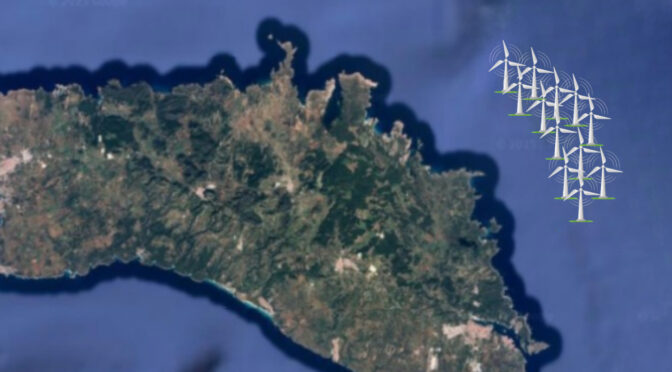Views: 1217
The GOB has submitted a document with considerations to the Ministry for Ecological Transition regarding the floating offshore wind farm project “Tramuntana Wind Menorca.” This is the second offshore wind farm proposal to emerge in Menorca. It involves larger turbines than the previous one and raises as many or more environmental uncertainties.
The project proposes 12 wind turbines, each 325 meters tall with a blade diameter of 300 meters and a capacity of 20 MW per unit. The proposed location is about 5 kilometers off the island’s northeast coast.
The project does not assess the potential noise impact. As these turbines are not yet commercially available, there is no conclusive data in this regard. However, in turbines with much lower capacity (5 MW), acoustic incidences above 111 decibels have been evaluated.
Assuming the 20 MW turbines proposed in the project generate around 115 dB, this could mean that residential areas such as Es Grau or Sa Mesquida would experience sound pressure levels around 77 dB, which is significantly higher than the 55 dB allowed at night in residential zones according to municipal regulations.
It is important to note that the decibel scale is logarithmic. The 22.5 dB difference between the expected noise level and the permitted level in the closest urban areas to the wind farm represents an increase of over 100 times the allowed noise level.
Estimated levels of noise pollution would also exceed limits in the urban conurbation of Macaret and nearby developments, as turbines would be aligned with their latitude (with an estimated level of 76 dB). Likewise, the estimate for the town of Es Castell would reach 74 dB.
GOB has also requested a preliminary report from the Natural Park of the Albufera des Grau due to possible effects of the noise footprint on the natural environment. Furthermore, it has called for the creation of a detailed map of the seabed showing the biocenosis of the area and the potential mechanical impacts (from anchoring systems or dragging of mooring lines) as well as the acoustic impacts that can be expected.
The Tramuntana Wind Menorca project proposes a total capacity of 240 MW, a figure well above Menorca’s average peak demand, which is around 65 MW.
Currently, the island has over 61 MW of operational photovoltaic power, with another 25 MW pending connection and an interconnection with Mallorca of 118 MW, which could be doubled in the future with the installation of a second cable.
Even so, in a peak production scenario with 326 MW, neither local demand nor the capacity of the grid would allow for the full use of the energy generated. This production overcapacity could jeopardize the stability of the electrical system.
For this reason, it has been recommended that the project be limited to a proposal more in line with the island’s actual energy needs and with fewer environmental impacts.
GOB supports renewable energy. Considerable effort has been made in Menorca to develop models that are reversible in case they cease to operate in the future, allowing rural land to return to its agricultural function.
Solar photovoltaic energy makes up almost all the renewable energy developed on the island so far, and has the advantage of not distorting the landscape as much as wind farms. However, relying solely on solar means that renewable production only occurs during daylight hours. In this context, having a portion of wind energy could be beneficial to complement the current approach.
But the project proposed in the island’s northeast appears unrealistic. Some of the anticipated impacts would be difficult to accept, and the scale does not match the island’s capacity nor its energy infrastructure. Therefore, it is requested that the initiative be scaled down to more modest parameters and that, in any case, a pilot experience be conducted beforehand to verify the potential impacts.

